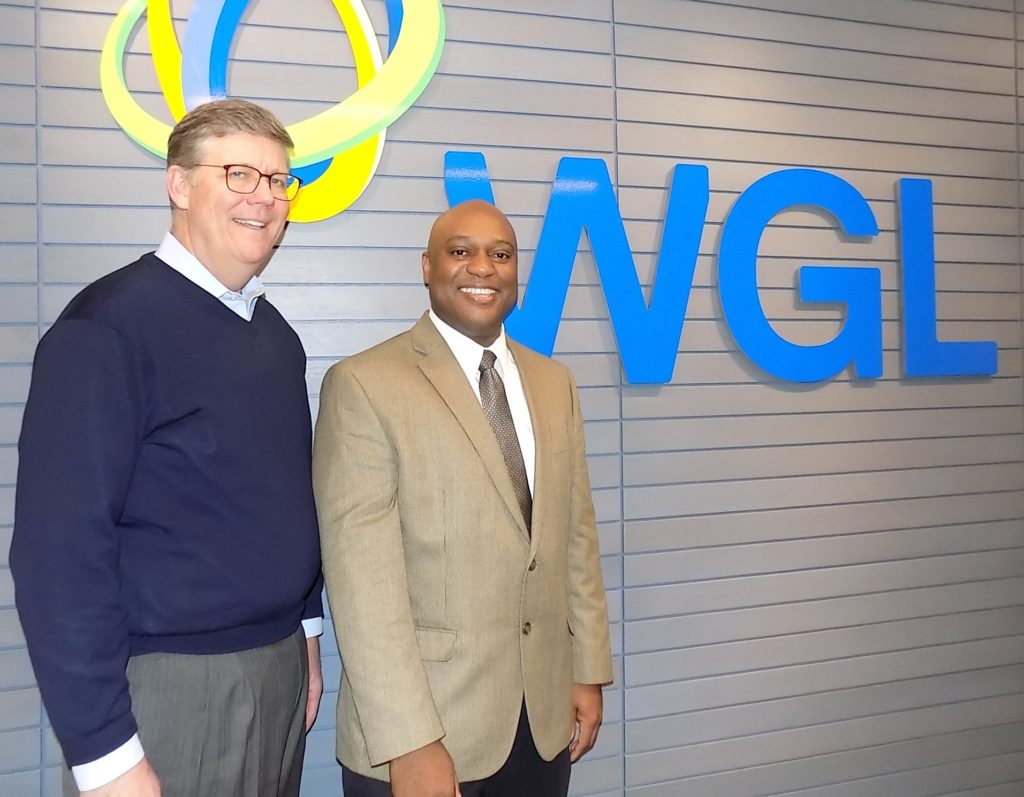Washington Gas: Lighting the Capitol for 170 Years
By • December 19, 2018 0 875

From its perch in one of the Wharf’s shining new buildings in Southwest D.C., the headquarters of Washington Gas — WGL Holdings, Inc., to be exact — looks high-tech and high-energy. With floor-to-ceiling windows, views of the Potomac River and Virginia give the place the feel of the future.
It was not always like that. During the 19th century, Washington, D.C., was behind other cities in taking up the use of the new gas technology. It took an act of Congress to push D.C. forward.
Living near the U.S. Capitol and lighting his home with gas, James Crutchett, an advocate of gas, drew support from the Senate and the House of Representatives, as well as from the mayor and business leaders. Soon enough, Congress allocated $17,500 to Crutchett to light the Capitol, and in July of 1848 Washington Gas Light Company was created.
A Washington Gas plant was located for decades at the intersection of New Hampshire and Virginia Avenues NW, on land that would later be the site of the Watergate complex. The plant was built in Foggy Bottom because nearby in Georgetown was the C&O Canal, bringing coal in barges from West Virginia and Pennsylvania. The company even had an aqueduct going over Rock Creek.
Nowadays, having a stove, a hot water heater or a furnace fueled by gas is a routine matter. But what has some Georgetowners concerned is the sight of crews responding to gas pipeline leaks — seemingly more than usual. Georgetown resident Edward Segal thinks so, and even maintains a blog to track the leaks.
Because of such concerns, Washington Gas representatives gave a presentation at the Dec. 3 meeting of the Georgetown-Burleith-Hillandale advisory neighborhood commission, acknowledging that they had to do a better job communicating with the community when jobs are assigned.
Leaks are graded 1, 2 or 3 based on the level of action they require. “We respond to every reported gas leak immediately to determine its risk,” said a Washington Gas rep, adding that the company strives to minimize parking and traffic disruptions.
The company has an ongoing solution in “PROJECTpipes” — its 40-year accelerated infrastructure replacement program — which started in 2014.
“Safety has been at the center of everything we do at Washington Gas since our founding 170 years ago,” said Adrian Chapman, president and CEO of Washington Gas, in a statement. “Like all older metropolitan systems across the country, our pipeline system in Washington, D.C., is aging. This next phase of PROJECTpipes will expedite the replacement of older pipeline so we can continue to deliver affordable gas service in the years ahead.”
As of Sept. 30, the company reports: “The initial four years of Phase 1 of PROJECTpipes has been implemented at a total cost of $78.1 million, with approximately $110 million total investment expected by September 30, 2019. For 2018, the amount of PROJECTpipes surcharge for an average residential heating customer was approximately $25 annually, or $2.08 per month.”
Phase 2 of PROJECTpipes, the company continues: “proposes to replace approximately 22 miles of pipe and 8,274 service lines from October 1, 2019, to December 31, 2024. If approved by the PSC, Washington Gas will spend approximately $305.3 million over five years. For 2019, the amount of PROJECTpipes Phase 2 surcharge for an average residential heating customer is projected to be approximately $49 annually, or $4.08 per month.”
“We also recognize the investment we are asking customers to make to help us improve our system,” Chapman said. “Fortunately, due to the substantial decrease in natural gas prices, customers actually pay less today for natural gas service than they did in 2007, even with the PROJECTpipes surcharge included in their bill.”
In 2014, the gas company renamed itself WGL with the mission of “being a new kind of energy company: answer-oriented, technology and data driven, responsive and built for the complex energy markets of today and tomorrow.” In July, WGL was acquired by AltaGas, based in Calgary, Alberta.
While Washington Gas may be broad in its scope, serving more than 1.1 million customers in D.C., Maryland and Virginia, it realizes that its gas crew just down the street in Georgetown is its link to the neighborhood and more important than ever.

